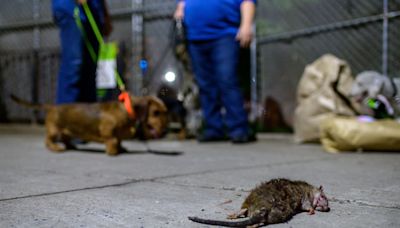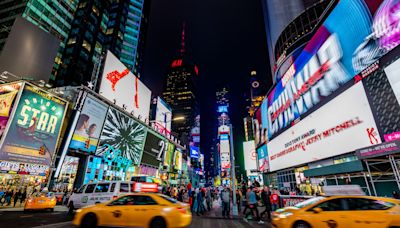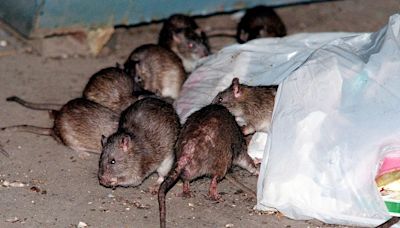Search results
Aug 9, 2023 · Brooklyn is one of the five boroughs of New York City, and it is coextensive with Kings County. It is the most populous borough in New York City with a population of 2.6 million. Brooklyn is located in southwestern Long Island and is separated from Manhattan by the East River. It is bordered by the Upper and Lower New York bays to the west, the ...
Aug 20, 2023 · In 1898, Brooklyn officially became a part of New York City. The consolidation of Brooklyn with the other four boroughs—Manhattan, Queens, the Bronx, and Staten Island—formed the present-day New York City we know. This consolidation brought significant changes to Brooklyn, including the development of transportation infrastructure and an ...
Brooklyn is a borough of New York City.Located on the westernmost end of Long Island, it is coextensive with Kings County in the U.S. state of New York.With 2,736,074 residents as of the 2020 United States census, Kings County is the most populous of the five boroughs of New York City and the most populous county in the State of New York.
- Kings (coterminous)
- United States
- New York City
- Breukelen, Netherlands
People also ask
Is Brooklyn a borough?
Where is Brooklyn in New York City?
Is Brooklyn a county?
Why is Brooklyn a part of New York City?
- Overview
- History
- The contemporary city
Brooklyn, one of the five boroughs of New York City, southwestern Long Island, southeastern New York state, U.S., coextensive with Kings county. It is separated from Manhattan by the East River and is bordered by the Upper and Lower New York bays (west), the Atlantic Ocean (south), and the borough of Queens (north and east). Brooklyn is connected t...
The first settlement in the area by Dutch farmers in 1636 was soon followed by other settlements in Flatlands, Wallabout, the Ferry, Gravesend, and, in 1645, Breuckelen—also spelled Breucklyn, Breuckland, Brucklyn, Broucklyn, Brookland, and Brookline; the present spelling became fixed about the close of the 18th century. Later settlements included New Utrecht (1650), Flatbush (1651), Bushwick, and Williamsburg (1660). The American Revolutionary War Battle of Long Island was fought in Brooklyn on August 27, 1776, with remnants of the American army retreating to Brooklyn Heights overlooking the East River. Early in the 19th century, Brooklyn became the world’s first modern commuter suburb, and Brooklyn Heights was transformed into a wealthy residential community. The most populous section of Brooklyn was incorporated in 1816 as a village and in 1834 as a city. Williamsburg and Bushwick were annexed to it in 1855. Other communities were absorbed until the city of Brooklyn became conterminous with Kings county (created 1683).
By the 1880s Brooklyn had become one of the country’s most important manufacturing centres, and its busy port was handling more tonnage than its counterpart in Manhattan. Sugar refining was the city’s largest single industry, but Brooklyn was also the site of ironworks (the ironclad battleship Monitor of Civil War fame was constructed at the Continental Iron Works in Greenpoint), petroleum refineries, slaughterhouses, and many factories. Clocks, cigars, beer, insulated wiring, electrical signs, packaged coffee, and even teddy bears were all produced in Brooklyn, which did not begin declining as a manufacturing hub until the 1950s, when manufacturers began relocating to less expensive locales.
Ranked among the most populous cities in the United States during the last four decades of the 19th century, Brooklyn had its own Academy of Music (1859) and Historical Society (1863). In the late 1860s Frederick Law Olmsted and Calvert Vaux, the architects of Manhattan’s Central Park, designed a system of parks and parkways for Brooklyn on a scale theretofore unseen in the United States. Parkways (the term coined by Olmsted and Vaux) radiated from 526-acre Prospect Park (1870s), stretching southward as far as Coney Island. Grand Army Plaza, featuring the John H. Duncan Memorial Arch, was later added as the park’s primary entrance. Notwithstanding these civic milestones, the construction of John Roebling and Washington Roebling’s Brooklyn Bridge to Manhattan (completed 1883) effectively doomed Brooklyn’s independent existence, as business interests craved closer ties to the metropolis. Overcoming the opposition of the local Democratic machine, Brooklyn accepted consolidation by a margin of only 277 votes and became a part of Greater New York in 1898.
Yet despite their economic and political subordination to Manhattan, Brooklynites maintained a fiercely independent identity that was buttressed by pride in their hometown Major League Baseball team, the Dodgers, who played in intimate Ebbets Field and whose Jackie Robinson broke the Major League’s colour barrier. (Significantly, Brooklyn had also been a magnet for Black Americans relocating from the South during the Great Migration.) The departure of the Dodgers for Los Angeles in 1957 was a huge blow to civic pride that coincided with the onset of the decline of the local economy as the United States began transitioning to the postindustrial era. Between 1954 and 1990 manufacturing output in Brooklyn was cut in half. Moreover, the Brooklyn dockyards fell into disuse, and in 1966 the Brooklyn Navy Yard was shuttered.
In the meantime, once-thriving neighbourhoods decayed and slid into poverty. A particularly low point for Brooklyn came in July 1977, when a New York City-wide power outage occasioned rioting, arson, and looting that resulted in widespread damage that was especially destructive in the Bushwick neighbourhood. Although the 1970s and ’80s were tumultuous in Brooklyn, by the 1990s the borough had begun to experience a turnaround. Neighbourhoods such as Brooklyn Heights, Fort Greene, Clinton Hill, and Park Slope were revitalized as young professionals and families looked to Brooklyn as a more affordable low-key alternative to living in Manhattan. In the process, Brooklyn’s industrial, largely working-class character began undergoing a significant transformation. In north Brooklyn an influx of artists turned Williamsburg into a hip bohemian enclave. Technology-based enterprises replaced factories. Neighbourhoods throughout Brooklyn became increasingly upscale.
Exclusive academic rate for students! Save 67% on Britannica Premium.
Today Brooklyn’s changing neighbourhoods—with their cornucopia of coffeehouses, bars, trendy restaurants, galleries, boutiques, and artisanal ventures—are a magnet for the businesses and young workers of the 21st century’s evolving “knowledge economy.” As Brooklyn became a major technology hub, employment in its technology sector increased by more than 57 percent between 2009 and 2017. The local innovation economy is founded on three pillars: technology-based start-up companies (many of them software producers), “next-generation” manufacturers (creating innovative hardware products with 3D printers and laser cutters), and creative businesses (including industrial design, motion picture and video production, sound recording, and advertising).
Brooklyn’s extensive transportation network consists of subways, buses, and ferries, and the city is the western terminus of the Long Island Rail Road. The borough is home to Pratt Institute (1887) and the New York University Tandon School of Engineering, as well as branches of the City University of New York, the State University of New York, and Long Island University. Among the cultural attractions are the Brooklyn Botanic Garden and Arboretum, the Brooklyn Museum, the Brooklyn Academy of Music, the Center for Brooklyn History, the New York Transit Museum, the Brooklyn Children’s Museum, and the Jewish Children’s Museum. The National Basketball Association’s Brooklyn Nets and the Women’s National Basketball Association’s New York Liberty play in Barclays Center (2012). Since 2001 Brooklyn has also been home to a minor league baseball team, the Cyclones. Brooklyn-based publications include the Brooklyn Eagle newspaper, first published in 1841; Brooklyn Magazine; and the influential, mostly music blog Brooklyn Vegan. Famed native sons and daughters include composer George Gershwin, lyricist Ira Gershwin, U.S. Supreme Court Justice Ruth Bader Ginsburg, filmmakers Woody Allen and Spike Lee, world heavyweight boxing champions Floyd Patterson and Mike Tyson, Baseball Hall of Fame pitcher Sandy Koufax, basketball player Connie Hawkins, singer-actress Barbra Streisand, rappers JAY-Z and the Notorious B.I.G., and writers Arthur Miller and Norman Mailer.
Brooklyn has many distinctive neighbourhoods. Brooklyn Heights offers panoramic views of Lower Manhattan from its promenade along the East River; Brownstone homes line the leafy streets of Park Slope; and Carroll Gardens retains its Italian American heritage while abounding with fashionable restaurants, shops, and bars. DUMBO (Down Under the Manhattan Bridge Overpass) has emerged as one of New York City’s best-known arts districts, and Coney Island’s oceanfront beach, boardwalk, and amusement rides (including the famous Wonder Wheel [1920] and Cyclone roller coaster [1927]) make it a popular warm-weather destination.
Even as it gentrified, Williamsburg continued to enjoy a reputation as a hipster haven, though many artists have decamped to other neighbourhoods, notably Greenpoint, Gowanus (with its namesake canal), and Bushwick. Bedford-Stuyvesant, long the centre of Brooklyn’s Black community, has coped with poverty and urban blight but is undergoing a resurgence. Little Odessa in Brighton Beach is the locus for expatriates from Russia and other countries of the former Soviet bloc. Indeed, Brooklyn is home for immigrant communities from Latin America, the Caribbean, China, Korea, the Middle East, and elsewhere. Despite its 21st-century renaissance, however, Brooklyn also still contains swaths of poverty.
Dec 11, 2018 · Brooklyn is one of the five boroughs of New York City, along with Bronx, Manhattan, Queens and Staten Island. It is the largest borough by population and has a rich history of Dutch colonization. Learn more about the other four boroughs and counties of NYC.
- Matt Rosenberg
New York City's remaining four boroughs are collectively referred to as the outer boroughs. Brooklyn Landmark nineteenth-century brownstones in the Greenpoint Historic District of Brooklyn, New York City's most populous borough. Brooklyn (co-extensive with Kings County), on the western tip of Long Island, is the city's most populous borough.
New York City - Brooklyn, Urban Center, Diverse: The most populous borough of New York, Brooklyn occupies 81 square miles (210 square km) to the east of Manhattan on the western fringe of Long Island. Sections of the area were first settled by the Dutch in the 1630s, and six largely agricultural towns—Brooklyn, Flatlands, Flatbush, New Utrecht, Bushwick, and Gravesend—soon thrived ...








